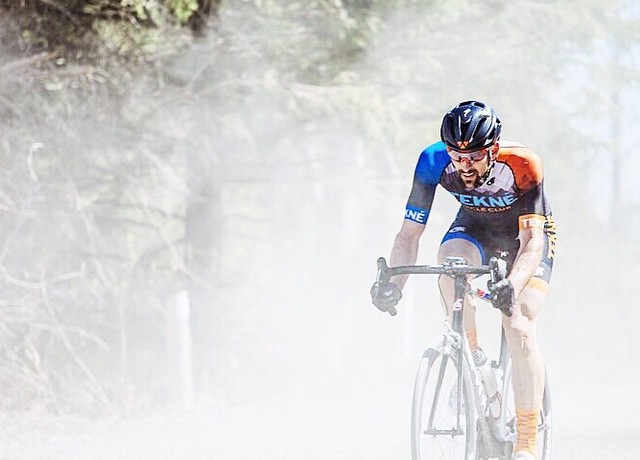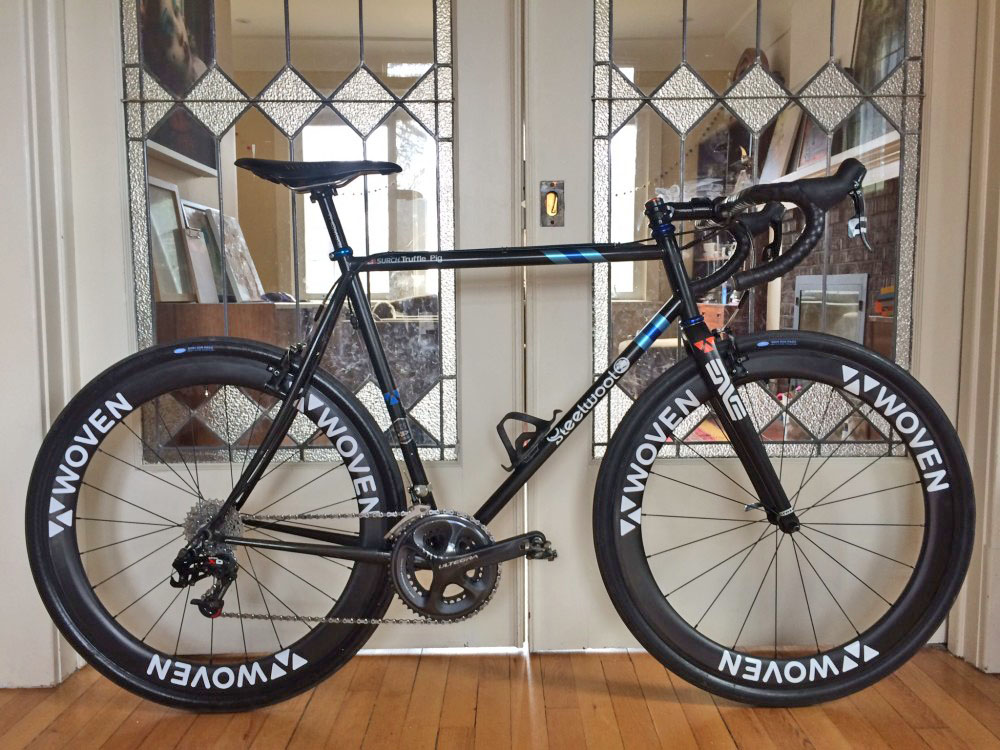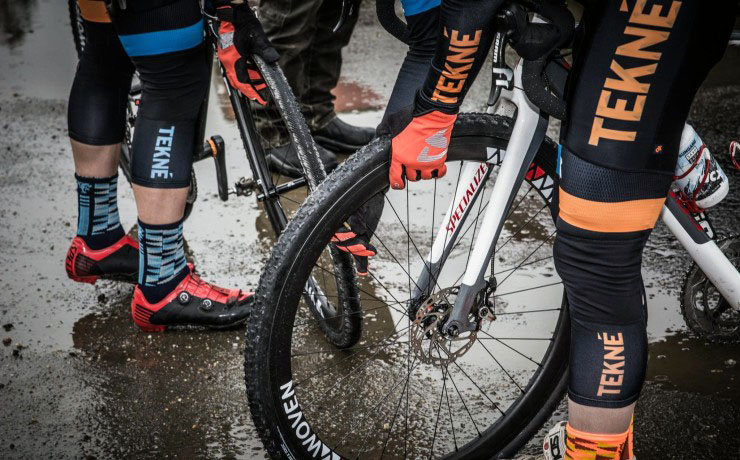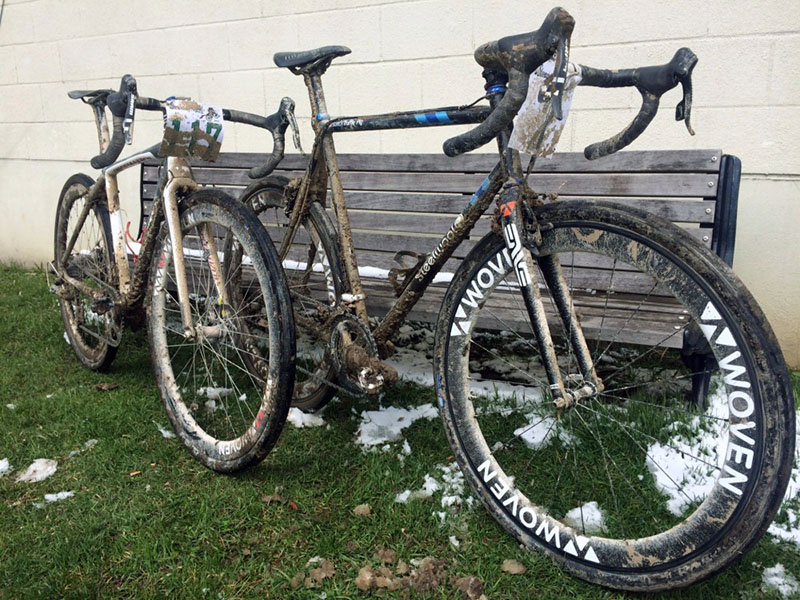Gravel Racing on Compass Tires

When the Australian Matt Hayman won the European Paris-Roubaix race yesterday, it came as a huge surprise to everybody, including Hayman himself. However, nobody was surprised that Hayman rode on super-supple tires. With their tan sidewalls, Hayman’s tires looked like FMBs or Dugasts, but first reports insist that they actually were made by Continental. It’s an indication how far we’ve come if Continental really is making 28 mm tubulars with tan sidewalls and supple casings. (Of course, with pros, you always wonder what they really ride.)
Closer to home, there is little mystery in the tires that long-time Bicycle Quarterly reader Matt Surch (above) used to win Ontario’s season-opening gravel race, the Steaming Nostril. He isn’t sponsored by anybody, and we were excited to learn that he chose Compass Bon Jon Pass tires for his winning ride. I used the opportunity to catch up with Matt and ask him about gravel riding, bike and tire choices, and his training.
JH: Congratulations on winning the Steaming Nostril. Can you tell us a bit more about the race?
Matt Surch: Thanks Jan! It felt fantastic to kick off the season so well with my teammates! The Steaming Nostril is a 70 km loop from St. Jacobs, Ontario. The course begins with pavement, then mostly covers gravel roads that are well packed and have the typical potholes for this time of year. Long straight lines and strong winds favour those with strength and pack-riding skills.
After covering about 55 km, the course gets exciting! A new sector this year saw us enter a Mennonite farm on a dirt lane. We descended an absolutely gnarly rutted path into a valley, where we followed a freshly cut trail of grass and mud to a veritable muur [wall] of muddy singletrack. Completely unrideable, on any bike, this climb required cyclocross shouldering (below). After this sector, the race took us over a beautiful span of twisting and undulating packed dirt, some more pavement, and the final challenge: 6 or 7 flights of wooden stairs. From there it was about 50 meters to the finish line. The eclectic mix of surfaces and features made for a tactical and fun race.

You’ve been racing on gravel longer than most. What attracts you to that part of cycling?
I grew up through the 1990s obsessed with mountain biking, and that’s where I began racing. I raced cross-country for years, then transitioned to downhill, which I pursued through my early 20s. When I had enough of the grind of racing, I shifted focus to skills-based riding: dirt jumping, street (in the BMX sense), and park (skatepark) – squarely centered on fun and progressing skills. But then I was tempted to try a local ‘spring classic’ race, the Ottawa Bicycle Club’s Paris-Roubaix. Yes, that’s the real name.
Ian Austen started the event about 25 years ago, and it’s a cult classic in our region. It’s 75 km of mostly dirt roads with a number of forest sectors that are trails or double-tracks. The first year, I did it with a gang of friends, and we all rode fixed-gear bikes with 28 mm or larger tires. It was really fun, and a great way to get into ‘road racing,’ though it was obviously far from that. The next year I tried again, this time with gears, and was more of a participant in the race, though I had no idea what was going on up front. My third year, I was able to ride close enough to the front to finally understand what was happening, and that was the spark I needed to really latch onto road racing.
I love how the gravel races bring out a huge spectrum of riders, from those who take them seriously to those who consider them ‘challenge rides.’ We all ride the same courses, and we all struggle in our own ways. They also tend to be ‘open category’ races, so they let us friends race together, rather than being split us up into the usual race categories.
There’s generally a strong sense of camaraderie between riders, be they at the front, the middle, or the back. I love that, trying to smash each other in the race with attacks, then laughing about it and sharing food and drink afterwards. (My drink of choice is kombucha!) We all have war stories…
The community aspect of the gravel races really speaks to me, too. They tend to be run out of small towns that get behind the events, and that is really heartening. We get to travel to these places off the beaten track and learn about the history and culture of the regions. I love that.
There’s more to it. I’m rarely the strongest rider in a race, but I’ve got as much skill as just about anyone I face, so I always try to figure out how to leverage that. Often I race with team-mates, and we spend time in advance of the races trying to work out different strategies, scenarios, and contingencies. That’s really fun, and different from road racing, where you’ll often know that there’s a hard climb that will be decisive… Often it’s really simple on the road. For the gravel races, we think about at what point we want a break or split to happen, then try to execute that plan, knowing that at some point it will come down to pure power and skill to seal the deal. I find this really exciting.
The other aspect I find really fun is the equipment. Each race has different demands, and I love working out the puzzle every year according to the conditions we’ll face.
You mention the equipment. Tell us about your bike!
I tend to use my cyclocross bike for these races. I have a custom Steelwool cx bike built with Columbus Spirit for Lugs; it’s TIG welded. I don’t’ have anything against other frame materials, but this is a bike that fits me perfectly and has served me well for years. I’d like disc brakes and more tire clearance, but that would require a whole lot of new wheels! My frame has curved seat-stays for a bit of passive suspension, which I find works really well for me. On the cyclocross courses and gravel roads this frame is comfortable, which I believe makes me fast. It also ‘planes’ for me well, which I love. I go with a pretty typical ‘road position’ on my bike for all these races, just a bit less drop to the bars than my road race bike. The only change I make for cyclocross is moving my stem up 5 mm and rolling my bars up slightly.

Wheels have always been a huge part of the picture for gravel racing, and I used to struggle with denting rims and puncturing. Over the last few years, I’ve been using Woven Precision Handbuilts carbon wheels, first for cyclocross (tubulars), then for everything I do on the road and cx bike. With the deep-dish rims, it took me a little time to adjust to the front end’s reaction to gusts of wind, but after a while I was fully adapted. I was amazed by how hard I could hit things with those wheels and not even have to true them. It turns out the deeper wheels can be very compliant, given their ability to bulge out their sidewalls (not the brake track) under impacts.
Believing that I am on equipment that gives me an edge gives me confidence. Most people would not tend toward deep wheels for gravel races, but I’ll take the aero gains whenever I can, even if going deeper adds a few grams.

I’m a pretty massive tire nerd, and this applies to every discipline I ride. I started on 28s, but I’ve come to love larger tires for the rougher terrain. I’ve even used a Niner 29er mountain bike, set up with drop bars and 2” Schwalbe Furious Fred tires, for the roughest terrain, and it was great. But I’ve learned through trial and error that my preference is to use the least amount of tread possible and the least amount of volume possible for a given race, in order to strike the best balance of low rolling resistance and aerodynamics, so I use Compass Extralight tires whenever possible.
I can literally feel the aerodynamic difference between 32 mm Compass tires and 38 mm ones, so I think about the hardest section of a race and how narrow a tire I can use and survive with, usually. I choose the tire that will let me ride at 100% intensity and probably not puncture. Sure, I could use the 38 mm option, but they are overkill most of the time. Instead, I look at how rough the fastest descent will be, and what volume I’ll need to do that well and safely.
I choose tread (some sort of knobs, from a diamond file tread up) on my tires when there might be ice and snow (Continental Speed), a bit of off-road that will have some mud and/or aggressive turning (Clement LAS, Bontrager CX0), and a ‘full tread’ tire (Clement PDX) for off-road parts that are really gnarly and will be soft enough for full knobs to penetrate and grip into. However, it’s uncommon to need more than the LAS “diamond file” treads for anything I race.

You won the Steaming Nostril on Compass Bon Jon Pass tires. You aren’t sponsored, so you could have chosen any tire. Many readers would expect you on knobbies for a muddy race. Why did you chose the Bon Jons?
I’d been testing the new tubeless 35 mm Bon Jons, and they were working extremely well in tubeless format on the pavement and dirt roads. Planning for the same course as last year, they seemed like a great choice, even if they were a bit bigger than I needed. If the Compass 32s were tubeless-compatible, I’d have considered them ideal. I wanted the low rolling resistance of the tubeless format and the puncture resistance!
As to the smooth tread, the gravel roads were totally wet and muddy, yet traction was not an issue at all. The only issue was keeping mud off my glasses and trying not to collect too much as it froze onto the bikes! We’d been told by a rival that there was a new crazy sector while we were lined up for the start, so we knew there would be a surprise. When I hit the rutted descent I knew that tire tread would be irrelevant; it would come down to having the front wheel swallowed or not. Mine was, and I went over the bars! Fortunately, mud is soft, so I was back on my feet within seconds.
The trail bits that followed were a bit more difficult on tires with minimal tread, but one can adjust by pushing a harder gear to reduce the torque that makes the rear wheel spin. In fact, I made up ground here on my rivals with their knobby tires, perhaps in part because the minimal tread of the Bon Jons was not picking up as much mud… Once out of that sector, I had the advantage back, as the rest was definitely suited to the smooth tires.
I always look at whether I can use Compass tires rather than my other options, which have more tread and are more robustly constructed. Essentially, I want the EL’s super-supple casing and low rolling resistance whenever I can use them. Because I’ve got the option of using up to the 38 mm-wide tires now, the tires can handle some pretty extreme rough stuff. With the wider tires, I can run low enough pressure that the tires can absorb sharp impacts rather than get cut. When I match the tire correctly to the conditions, I feel like I’m just floating along, totally in tune with the road. It’s the suppleness of the tires and the compound that contribute to attaining that harmony. I love that. Stiffer tires simply can’t feel that way, and there certainly are not any tires out there that compare in the 32, 35, and 38 mm 700c sizes.
I often think that I’m riding tires similar to the best tubulars the pros use for races like Paris-Roubaix, but without the hassles of tubulars, and with lower rolling resistance, especially with the tubeless Bon Jons. Honestly, I’m convinced the Bon Jons are the fastest rolling 35 mm tire the world has ever seen in tubeless format. I just can’t see how anything else could compare.
What tire pressure did you ride in the race?
Low pressures are key for traction and floatation on gravel. I used 50 psi (3.5 bar) on the rear and 47 psi (3.2 bar) on the front. I weigh about 162 lb (73.5 kg).

Sounds like there is an active gravel racing scene in Ontario. Tell us about it!
Around Toronto and Ottawa (my home town) there are a good number of gravel events that mostly focus on spring. Both cities have strong cyclocross and road scenes, which contribute to the popularity of these events. The season kicks off with the Hell of the North (formerly organized by Mike Barry of Mariposa) in March, followed by the Steaming Nostril (both in the Toronto area), Paris-Roubaix (we call it the Almonte Roubaix), the Clarence-Rockland Classic (outside Ottawa), and Paris to Ancaster (Toronto area), which is the biggest, pulling in thousands or riders, including cyclocross stars from the US. We head down to Vermont for the Rasputitsa Gravel Road Race in April, which is a favourite.
Later into the season we return to New England for the fantastic Vermont Overland race, which is really hilly, and has some very challenging Class 4 ‘road’ sectors, which are referred to by locals as ‘Vermont Pavé’. This race is awesome, my favourite parcours of all, because it’s so technical and exciting. Plus, the event brings in such an amazing crowd, and their meal after is incredible.
How do you prepare for the races?
The spring races are the hard ones to prepare for, because we have full-on winter here in Ottawa. It’s dark, cold, snowy and icy from December through March, so we really have to be disciplined in order to get the fitness where it needs to be to be good for these races. While many locals head south during the winter for training camps, I stay home and put in lots of time on the trainer in the basement. I don’t really take a break after cyclocross season ends at the close of November, but just get onto the bike every day – normally in the morning before work, then at night – and keep moving. I go by feel rather than follow a rigid training schedule. That means I ride hard when I feel good, and I ride easy when I don’t.
There are a couple ‘anchors’ to my weeks over the winter. On Thursday nights I started doing Zwift races this past winter, which ended up being amazingly high intensity training. I found I was able to push to 100%, whereas I couldn’t normally do that inside. These sorts of workouts are key for me through the winter, along with the shorter interval sessions I pepper in. I also like to work on things like high cadence, prolonged standing, and low cadence on the trainer. All of these things are meant to target weaknesses and give me more tools to work with in the races.
Every Sunday in the winter (except when the weather/roads are insane), 3 to 12 friends ride a three-hour loop on snow-covered dirt roads. We tend to draw a line at colder than -15° C at the start; if it’s colder than that, our feet have a hard time staying unfrozen. We do the loops at a pretty steady tempo, and the great thing is that the climbs are not so long that we get really hot, and the descents are not so long that we freeze. After a week of pedaling inside, these Sundays are special, even if we have to wear ski helmets, goggles, mitts and two pairs of shoe covers over winter shoes.

Obviously, you train a lot. As in most races, you probably won mostly because of your fitness. What other factors played a role?
Fitness was definitely a big factor, but my team-mates were also key to making the win possible. Marc Hunt was out in a break of 2 for 20 km, which forced our main rivals, Wheels of Bloor, to try to bridge. Iain Radford and I simply could chase down each attempt, and other riders helped. So that was pretty straightforward. Once they were absorbed, a split occurred, and it was a matter of reacting to attacks. I ended up going into that gnarly sector with just two others, one being last year’s winner.
What about rider skill? How is racing on gravel different from racing on pavement?
Because ‘gravel’ events can vary widely in terms of what they throw at riders, the range of skills required also varies for a rider who wants to do well across the board. The most road-like events we do, like the Clarence-Rockland Classic, only use actual roads – paved and gravel. There’s not a lot of turning, so riders don’t need to be really adept there. They do, however, need to know how to ride relaxed over rough surfaces, and choose their tires well. Wind is usually a factor in races like this, so if a rider is strong, but doesn’t have good pack riding skill, they won’t be able to do well. The longer races in the US, like the Dirty Kanza, are similar in that they are quite open and windy. If I was doing that race, I’d be all about my aerodynamics and making sure I was not riding alone until I had to.
The more technical courses, like the Almonte Roubaix, Paris-to-Ancaster, and Vermont Overland require specific off-road skills for riding light over roots, rocks, mud, and steep ascents and descents. The sectors these races use are essentially trails people would normally ride mountain bikes on. In our case, cyclocross bikes are the best choice for all the faster and smoother parts, so one has to be able to ride drop bars with skinny tires through all that rough stuff. So looking way ahead is essential, as is being light and fluid on the bike to ‘roll with’ changes of direction when the wheels deflect off rocks and roots. Or mud ruts!
Mountain biking teaches riders to stay calm, let go of the brakes, and just go with it when facing difficult sections, and this is exactly what is required on the ‘gravel bikes.’ Without suspension, it’s key to be able to hop over the worst obstacles that can smash wheels, and even slide both wheels through turns at times. Really, all the skills riders learn in cyclocross translate well, though there is often much more speed involved in these races, which is where mountain bike experience helps. But shouldering and running with the bike is a cyclocross skill that will sometimes be key in a ‘gravel race’. If you can get off and run, and be faster than riding, you should run!
One cool thing about some of the gravel races is that riders with very good descending speed can use it to catch back up after being dropped on climbs. You can’t win on the descents, but you can often ease up a bit on the last part of the climbs then catch back on without using extra energy. I love that.
What advice do you have for riders who want to try riding on gravel?
Riding on gravel must seem scary to a lot of riders, and I understand why. The fact that most ‘road bikes’ are sold with narrow tires (23 – 25 mm) can’t help the situation. Whenever I counsel friends and colleagues on new road bike purchases, I always encourage them to get a bike that fits at least 30 mm tires. A bike with 30 mm tires is so much more stable on gravel. But ‘gravel,’ as a category, is so ambiguous; the truth is that lots of dirt roads around here are actually really smooth in the summer, and don’t require anything special to ride. But if we’re talking about loose gravel, more volume in the tires is the name of the game. Over the years we’ve learned that volume is the key to stability on unpacked surfaces like those of gravel and dirt roads; knobs can’t do any work when the substrate under them is shifting.
Gearing might need to be lower than usual for getting out into the gravel, as these roads are often steeper than what we usually find paved. Compact cranks are always a great place to start!
A good pump is key to fixing the flats you’re likely to encounter while on gravel adventures! That’s ok, it’s part of the learning curve! It’s really important not to overinflate tires. Riding a low pressure avoids unnecessary cuts and improves comfort and stability. Don’t be afraid to get it wrong sometimes! Just stop to add air to your tires mid-ride, if they don’t feel stable enough, or they are bottoming out on the bigger bumps.
If you want to try an event, I’d suggest finding one close to home and jumping right in! While riders like me geek out on marginal gains stuff for all these races, the majority of riders don’t need to worry about any of that. Lots of events are doable on a ‘normal’ road bike with 28 mm tires or a mountain bike. If there are technical parts that will be hard to navigate, use mountain bike shoes and pedals so you can walk. It’s not a big deal to get off and take the safe way. If riders have rando bikes, awesome, those are great for these events! I’d suggest removing the fenders if grassy or freezing mud is involved, unless you have huge clearance. At the Steaming Nostril, fenders would not have worked at all. Ride with one or more friends and share the experience, or, make new ones! I’ve met so many fantastic people while doing D2R2 (Deerfiled Dirt Road Randonnee) over the years. Just give it a try!
Thank you very much, Matt, and good luck with the other races this season!
Further reading:
- Matt’s blog: http://teknecycling.com
- Matt’s post about gravel races in the Ontario/Vermont region.
- More information about Compass tires.
Photo credits (in the order they appear):
1. Zara Ansar, from Clarence-Rockland Classic 2015
2. Cycle Waterloo, Steaming Nostril 2016
3. Matt Surch
4. Rasputitsa Gravel Road Race 2015
5. Matt Surch
6. Paris-to-Ancaster 2015 (photographer unknown)
7. Rasputitsa Gravel Road Race 2015
Correction: Initially, the front and rear tire pressures were reversed, showing a higher front tire pressure. Matt runs slightly more air in his rear tire than his front.


